Ghanaian Banquet at Palace Gate - Thursday April 19th
Ghanaian Banquet at Palace Gate - Thursday April 19th
-
-
-
-
-
-
Post #31 - April 20th, 2007, 8:38 amFirst a sincere thank you to Erin Metz, Gary Alan Fine and Peter and Abena Kwame the gracious owners of Palace Gate for a wonderfully interesting and delicious evening.
Abena and Peter Kwame, Erin Metz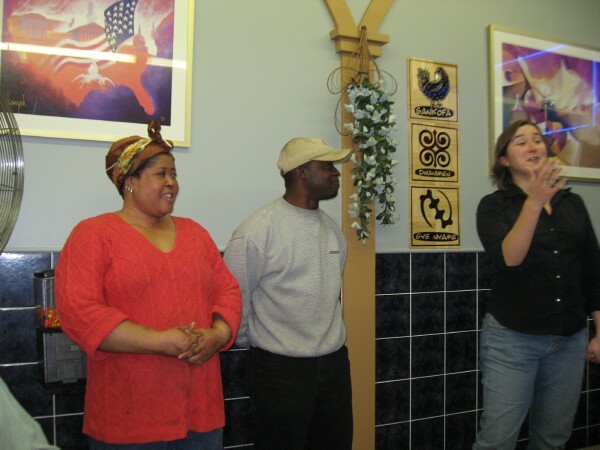
Gary Alan Fine caught mid-story.
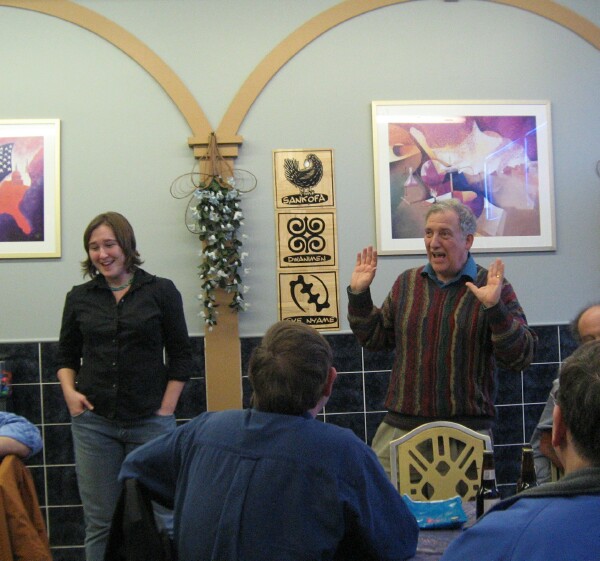
The Time to Make the Donuts guy thinks he has it tough, HA, let him try his hand at making Fufu sometime.
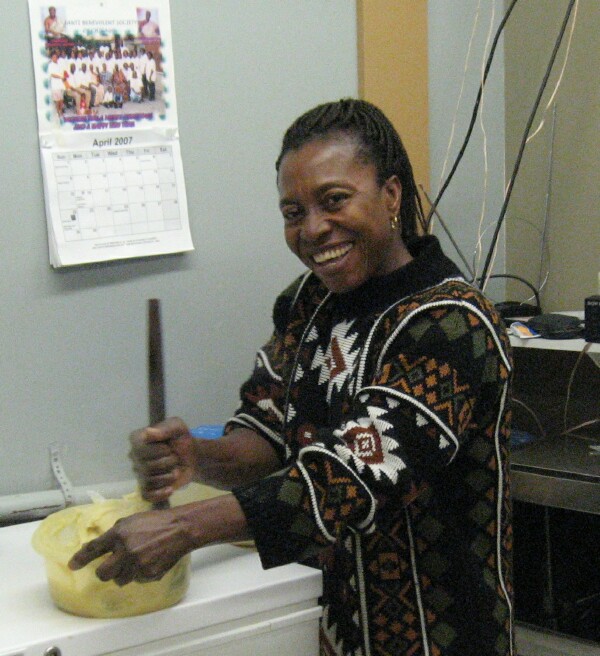
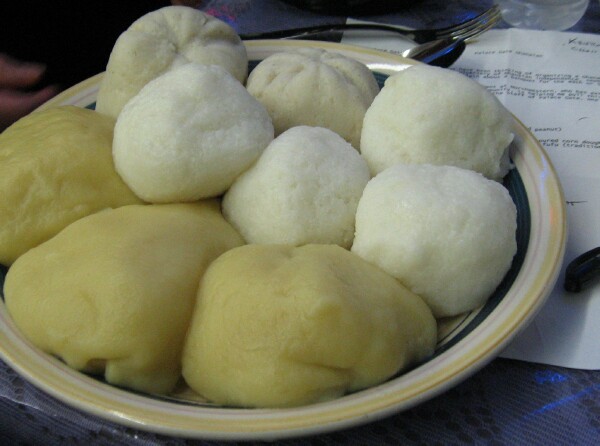
Kenkey was the most interesting dish of the evening for me, not so much for the kenkey itself, but for how it reinforced my understanding of the alchemy of flavor. By itself kenkey, a strong flavored mix of fermented corn and cassava, was not delectable, when eaten with just a bit of the tradition accompaniment, a simple tomato and onion mix, it burst with palate pleasing flavor.
In reading Erin's Ghanaian Food primer, I understand Kenkey is also typically paired with fish or meats with a side of gravy, which is what I believe cooked tomato/onion is referred to as.
Kenkey tomato/onion mix to right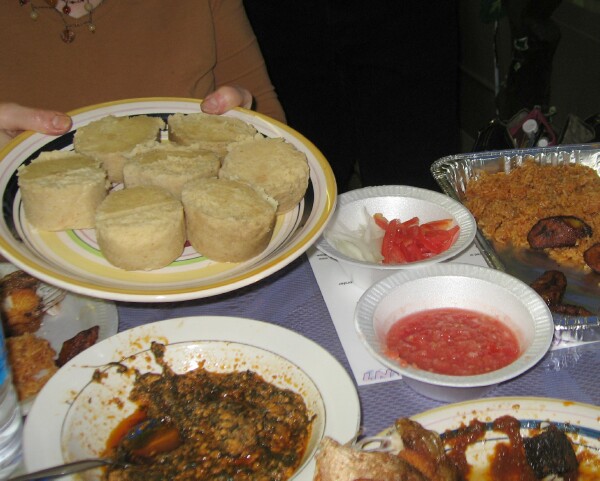
The other dish I found both interesting and delightful was Nkrumahkwan (Okra) stew. Frankly, it looked like, ummmm, well, lets just say it was green and highly viscous, but when eaten it was light on the tongue, almost airy, with a delicate mouthfeel and taste reminiscent of freshly grated onions. I woke up thinking about this dish.
G Wiv and Hammond with Nkrumahkwan (Okra) stew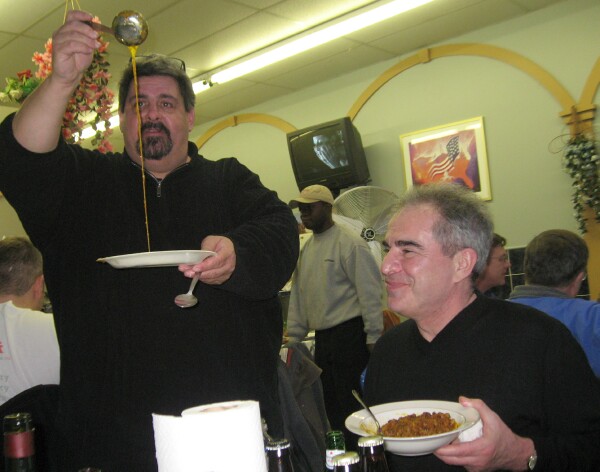
It was a terrific turnout, thanks again to GAF for organizing.
Happy Stomach and friend
Cathy2
Carolyn and Hammond
Germuska, Crrush, Kristina, Chris, nr706
MsWiv, Carolyn
I've put both Palace Gate's menu and Erin Metz's Ghanaian food tutorial on-line, menu images are large size files.
Erin Metz's Ghanaian food tutorial
Palace Gate Menu, page 1, page 2
Lovely evening, I'm looking forward to returning to Palace Gate.
Enjoy,
Gary
-
-
Post #32 - April 20th, 2007, 9:27 amThanks for the reports. The food looks great and the okra stew looks, uh, interesting. Erin Metz's food primer is extremely informative. I love her enthusiastic tone.
-
-
Post #33 - April 20th, 2007, 9:40 amaschie30 wrote:The food looks great and the okra stew looks, uh, interesting.
Indeed:
http://lthforum.com/bb/viewtopic.php?p=125055#125055"Don't you ever underestimate the power of a female." Bootsy Collins
-
-
Post #34 - April 20th, 2007, 12:08 pmI posted my photos to the LTH Flickr Group. As usual, by the time the food came out, I forgot to keep shooting -- but I can always count on my fellow LTHers to maintain coverage.
Here are a few that I liked most:
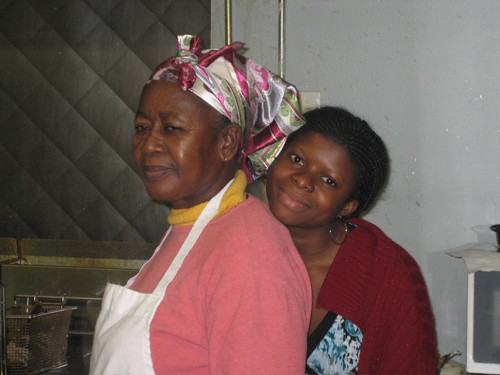
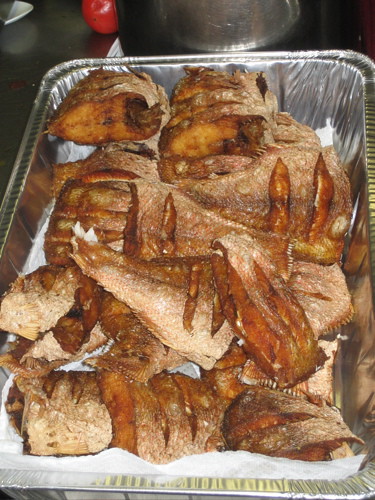
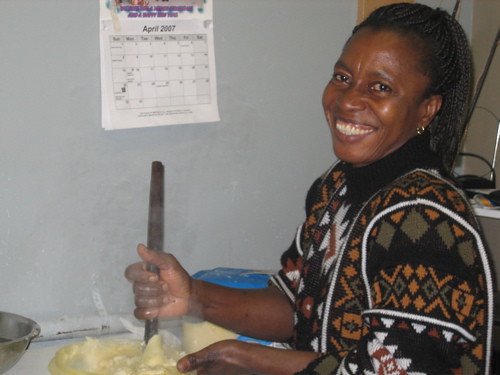 Joe G.
Joe G.
"Whatever may be wrong with the world, at least it has some good things to eat." -- Cowboy Jack Clement
-
-
Post #35 - April 20th, 2007, 2:04 pmBTW, what a cad I am -- I didn't even say thanks to GAF, and especially to Erin, who left last night before I could say it to her face.
She really put a lot of energy into the evening, even helping serve the meals and making sure everyone was figuring out how to proceed (which may sound comical, but eating in traditional Ghanaian mode with no utensils and some occasionally... er, ornery starches meant for conveying food from platter to mouth -- well, let's just say I need a lot more practice. As I mentioned to some folks, I had the same problem I often have with Ethiopian food, multiplied several times. I end up filling up on the starch because I don't have very good technique. I don't know how you'd ever actually finish a bowl of one of those stews! I'm sure the locals have it down but I found it very challenging...)Joe G.
"Whatever may be wrong with the world, at least it has some good things to eat." -- Cowboy Jack Clement
-
-
Post #36 - April 20th, 2007, 4:48 pmActually, just guessing, but I'm willing to bet that, in most African countries, filling up on starch is a major element of the exercise -- starch is generally more available than meat. So you were probably eating more authentically than you know, germuska.
I like the comment Erin made early on -- that having food up to your elbow showed you were having a good time. Many of us came close to that.
It was a splendid evening, and the people were a big part of that -- not just the LTHers (and sincere thanks to GAF and Erin for planning this), but also to the folks at Palace Gates, who were absolutely charming and eager to help us enjoy our evening. (For example, fairly early in the evening, trying to use the starch scoop to get stew to my mouth, I dripped sauce on my shirt, and excused myself to go wash it out. Only a few minutes after my return to the table, one of the older women from the kitchen came out and tucked a white apron up around my neck. I was delighted with their thoughtfulness.)
The evening was a perfect embodiment of what Erin told us Ghanaian eating is -- that is, in Ghana, you never eat without inviting others to join you, even strangers. It's actually a taboo to eat in public without inviting others to join you! Eating is all about sharing. And that we did. We opted for traditional Ghanaian style, which means a big bowl on the table and everyone at the table eats out of the same bowl.
While I share many of the reactions already expressed, I had a few more, so I thought I'd add my own thoughts.
We started with spicy kebabs -- tough meat but GREAT flavor. This might be one of the easiest things for newcomers to try. Other than taking a long time to chew, it was not really culinarily challenging.
I've had fufu at Bolat, but it was starchier there and less interesting. The fufu at Palace Gates was made from African yam and plaintain, so it was more flavorful. It was also rather sticky, which made it harder to form into the little flattened blobs with thumb-hollowed holes for holding sauce, but I still liked it better. The rice balls were easier to eat with than the fufu, but again, I'd probably try the fufu again. Erin said that this was kind of a base-line meal -- good, but in some cases, the dishes will be better when not cooked for the masses.
The fufu and rice balls were served with groundnut stew, which would be a familiar taste to anyone who has had any form of African peanut soup. It was yummy. A fish stew was also served, which we were told was a Sunday special dish. It was rich and flavorful, but a bit too fishy for my tastes (but then, I'm not a fan of very fishy fish, and even salmon is borderline -- if you love fishy tastes, this might be heaven).
"Red red" was the name given for a multi-part dish that consisted of bean stew, red rice, and fried plantains. It was easy to see this as an early progenitor of red beans and rice. It was delicious. I think this would be something else the less adventurous could enjoy without getting too far out of their comfort zones.
Kontomire was greens (cocoyam greens, we were told, and I just learned recently that cocoyam is taro, so if you've eaten taro leaves in Hawaii, you know what this is). This was cooked with tomato, chilies, and onion (defined for me recently as basically the sofrito of Ghana, the base flavor of most cooking), as well as roasted gourd seeds. I'd had roasted gourd seeds, and roasted watermelon seeds, previously at Bolat, a Nigerian restaurant. It just doesn't work for me -- there's just something about the flavor that made this less than my favorite dish. This didn't keep me from enjoying it, it just seemed slightly "off." But there were others who ate it with relish and declared it their favorite of the evening, so this is clearly just a matter of taste. This was served with sliced, boiled, African yam, which I always enjoy -- it has a taste somewhere between white potato and cooked gourd.
The kontomire was served with fried tilapia, which was very fresh and tasty.
As mentioned by others, the okra stew had an off-puttingly mucilagenous texture, but the flavor was magic. It was light and beautiful. This was served with fried snapper that was incredibly crisp and delicate in flavor, with firm, white flesh. Tasty fried chicken was also served.
Also as mentioned by others, I was amazed at the transformation of the kenkey by the addition of the tomato/garlic relish (like African gaspacho, as germuska observed). Erin said that this wasn't even the sourest kenkey she'd ever enountered, and it was in fact a bit on the mild side. I appreciate that, because I'd probably still be puckering if it had been any more sour. But again, with that tomato mixture, it was fabulous.
So an amazing meal. I still haven't needed to eat, having consumed so much last night. While this is not going to unseat Chinese, French, Thai, and Italian from the top spots in my culinary pantheon, it was culinarily fascinating, some of it was tasty enough that I'd try it again, and it was definitely an education. And, in fact, I'm looking forward to reproducing the groundnut soup. So a few dishes will be making their way into my recipe line-up, and I will be getting back to Palace Gates for a few more experiments.
I'd recommend that anyone with a sense of adventure try it out. And a nice bonus is that there is an African grocery store right next door, so you can kill two birds with one stone -- shop for food and dine out -- perfect LTH one-two punch.Last edited by Cynthia on April 20th, 2007, 9:05 pm, edited 3 times in total."All great change in America begins at the dinner table." Ronald Reagan
http://midwestmaize.wordpress.com
-
-
Post #37 - April 20th, 2007, 5:12 pmA few more thoughts.
The two times previous to this that I've had Ghanaian groundnut soup/stew, it was made with chicken. Last night, it was made with goat, which gave it a deeper, richer flavor.
Erin mentioned that dessert was not common in Ghana, though we were given pineapple (which helped settle our tummies, as the food had not only been abundant, but also rich with palm oil and generally quite spicy). The note on this is that it makes sense they wouldn't have desserts. The idea of ending a meal with something sweet was kicked off by the Romans, and only cultures that were conquered by or descended from (even if just philosophically) the Romans have desserts as part of their meals. Same with lettuce-based salads. Stray outside of countries that trace their thinking to the ancient Mediterranean, and you won't find any lettuce-based salads, either.
One of the cooks, who also helped with serving, told us that anything we left would be thrown out. They cook fresh every day. Slow Food would be proud of them."All great change in America begins at the dinner table." Ronald Reagan
http://midwestmaize.wordpress.com
-
-
Post #38 - April 20th, 2007, 8:58 pmCynthia wrote:Also as mentioned by others, I was amazed at the transformation of the kenkey by the addition of the tomato/garlic relish (like African gaspacho, as germuska observed).
I can't take credit for this... I think it was Dan.
But you make lots of good points and provide good detail to help me remember the evening better!Joe G.
"Whatever may be wrong with the world, at least it has some good things to eat." -- Cowboy Jack Clement
-
-
Post #39 - April 20th, 2007, 11:02 pmI polished off my leftovers tonight for dinner. I had no problem diving into the "red red," the beans, rice, and plantains dish. However, despite the fact that I loved it last night, it actually took an act of willpower to dig into the "mucus stew" once again. The okra tasted as good as it did last night, but that first visual of the viscous fluid almost put me off my feed. But my brain over-ruled my knee-jerk reaction, and I ate and enjoyed it. But it struck me as funny how ingrained our reactions can be, that even knowing I liked the taste I initially had trouble getting past the visuals."All great change in America begins at the dinner table." Ronald Reagan
http://midwestmaize.wordpress.com
-
-
Post #40 - April 26th, 2007, 8:48 amUnfortunately had not been keeping up with my LTh reading prior to this event as I would have loved to attend.
one question I have is were there any dishes with cassava or potato leaves?
I'm reading "A long way gone" by Ishmael Beah right now which takes place in nearby sierra leone and most of the market food mentioned contains these two items. I've had cassava leaves in indian food, but don't think I've ever eaten potato leaves and was wondering about them.Last edited by zim on April 26th, 2007, 11:50 am, edited 1 time in total.
-
-
Post #41 - April 26th, 2007, 9:38 amI believe the only leaves we had were the cocoyam (taro) leaves."All great change in America begins at the dinner table." Ronald Reagan
http://midwestmaize.wordpress.com
-
-
Post #42 - April 26th, 2007, 10:31 amCynthia wrote:I believe the only leaves we had were the cocoyam (taro) leaves.
This seemed to be the dish people referred to ask spinach, though I recall it was taro leaves, too. If I recall correctly, there were fried cassava pieces to convey and eat the taro leaves dish. This was my favorite dish of the evening.
Regards,Cathy2
"You'll be remembered long after you're dead if you make good gravy, mashed potatoes and biscuits." -- Nathalie Dupree
Facebook, Twitter, Greater Midwest Foodways, Road Food 2012: Podcast
-
-
Post #43 - October 18th, 2007, 8:52 pmErin and her husband Terry are back in Ghana and blogging about it. Today I found two food-oriented posts to share:
On plates
Where everybody knows your name...Joe G.
"Whatever may be wrong with the world, at least it has some good things to eat." -- Cowboy Jack Clement
-
-
Post #44 - October 19th, 2007, 8:49 amMy best friend, another Erin, is also doing dissertation work in West Africa. She's spent the most time in Guinea, but this summer she was in Ghana and sent me some food reports. She didn't mention Frankies, mochas or pancakes, but I did hear about "spaghgetty" and pizza.
In Accra: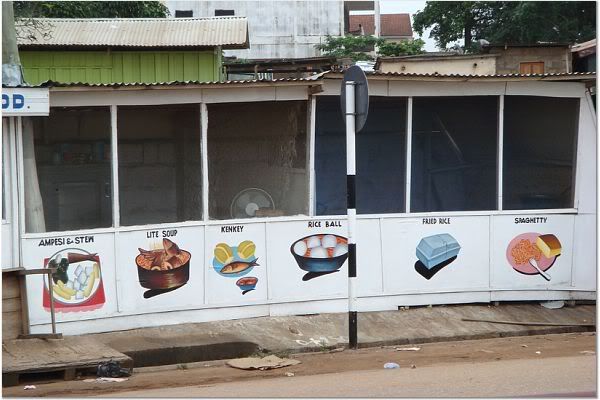
In Bolgatanga:
Erin kept sending me pictures of animals, and I kept saying, "Just send me pictures of your food."
I love Erin dearly, but we're still working on her food reporting skills. This is the only eating shot I got:
Warthogs in Mole National Park:
-
-
Post #45 - October 19th, 2007, 10:22 amThis dinner looked delicious! I recently went to Palace Gate and tried to order something like the above-featured dishes, and was flatly refused
 I ended up with jollof rice, plantains, and something that resembled mummified beef. So I have to ask, what do I have to say to convince them that I would prefer something with a bit more spice and flavor?
As a mattra-fact, Pie Face, you are beginning to look almost human. - Barbara Bennett
I ended up with jollof rice, plantains, and something that resembled mummified beef. So I have to ask, what do I have to say to convince them that I would prefer something with a bit more spice and flavor?
As a mattra-fact, Pie Face, you are beginning to look almost human. - Barbara Bennett
-
-
Post #46 - October 19th, 2007, 10:35 amI was at Palace Gate Monday. I did ask for a few things that weren't available, but putting myself in the hands of the gracious hosts (with some language barriers) I had a wonderful, spicy, groundnut soup with goat, served with fufu (I took leftovers home and munched on them for two days), as well as beef kebab (also spicy, and chewy in a nice way), jollof and kontomire.
As I say, there can be a language barrier, but if you just trust the servers to tel you what they have, what's good, and mention spicy, I think you'll do well.
-
-
Post #47 - October 19th, 2007, 2:44 pmI tried to indicate my desire for spice and something exotic, but they just refused. That happens to me from time to time; apparently I look like more of a Wonder bread type than I'd like to think.As a mattra-fact, Pie Face, you are beginning to look almost human. - Barbara Bennett

